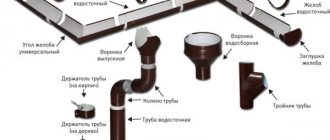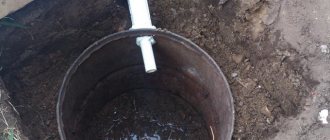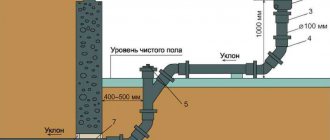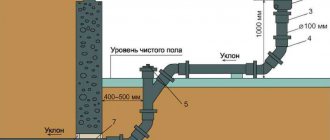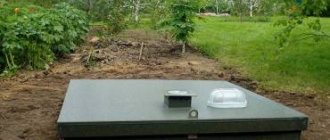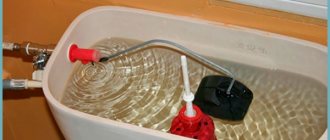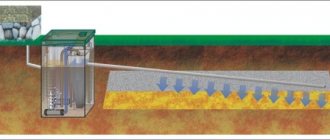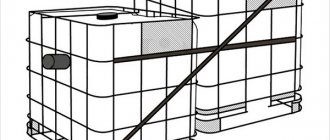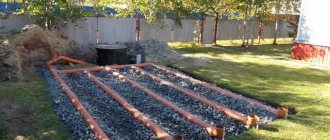Drainage sewerage is a system of perforated pipes, called drains, that function as one with the house's sewer system and septic tank.
At the same time, very often drainage sewers are made to remove wastewater from the bathhouse, because it does not contain large fractions and such water, which has passed through a layer of crushed stone and sand, can be passed into the ground without worrying about the state of the environment.
Storm drainage can also be installed. It is necessary to drain rainwater from the ground surface. In this case, trenches will be laid around the house, equipped with receivers of water coming from the drain.
Drainage sewer
Drainage ditch
One of the simplest and most accessible devices that allows you to drain water from a site is a drainage ditch. It is best to do this if the area has a slope in one direction.
It comes off to a depth below the freezing level of the soil. It is important to maintain a slope along the entire length towards the water drainage. Its size should be up to 3-5 centimeters per meter of length. This slope allows water to flow slowly enough, taking with it particles of soil, otherwise rapid silting of the storm drain of a country house may occur. See the rules for laying sewer pipelines in the ground. Storm sewerage in a private house in its own way
At the bottom of the ditch, approximately a third of the depth, a layer of wild stones or concrete scrap is placed. Then you need to pour coarse gravel, sand and cover it all with geotextiles. It will prevent rapid silting of the drainage channel. Ideally, the drainage ditch is led into the nearest storm drainage well.
In modern conditions, pipes made of various materials are used as drainage systems - steel or plastic. For greater strength, products with a corrugated wall are used for conductors of the second option. This design increases the radial strength of the product.
Storm sewer drainage ditches on the site can also be open, which simplifies their operation.
They come in the following types:
- perimeter - come off along the perimeter of the area that needs to be protected from excess moisture;
- the main ones are essentially the main channel of the river, to which tributaries converge in the form of additional drains.
How condensation occurs in an air conditioner
The operating principle of an air conditioner is similar to that of a refrigerator. The cold evaporator is blown by a stream of air, which is cooled and enters the room in this form. The constantly passing stream carries with it a significant amount of water vapor, which settles on the cold surface in the form of water droplets. If the temperature is set to low, the evaporator becomes covered with a thick layer of ice, which melts during pauses. A small installation can accumulate 20 or more liters of moisture per day, requiring organized drainage. If a whole network of installations operates in a room, the volume of condensate becomes a serious problem that requires an organized solution. The most successful solutions to the problem include draining the air conditioner into the sewer.
Storm drainage in a private house - arrangement methods
The purpose of the storm drain is to quickly drain rain and melt water during the period of greatest accumulation. The most common scheme is a surface storm drain around the house, consisting of open-top trays.
They can be cast concrete or made from prefabricated parts. Counting on a long service life, cast iron trays made by casting are used. But the most popular material for installing storm drains in a country house are plastic trays. They are quite light, durable and easy to install.
The trays are covered with grates on top to prevent clogging of the drainage channels with leaves and other debris.
But this method does not always pay off. In some cases, it is desirable to preserve the soil layer by deepening the drainage elements to a depth of about 40 centimeters. To do this, dig a ditch about half a meter deep and cover it to the top with geotextiles.
Gravel is poured onto the bottom of the ditch as a substrate, then the pipe is laid. Gravel is again poured on top of it. And here it is necessary to check one important point.
The fact is that for buried and deep drainage, perforated pipes are used, and holes are drilled in their walls. The diameter of these holes should be less than the fractional dimensions of the gravel. In this case, the internal passage of the drain will always be free.
In the classic version of use, the corrugated pipe is filled with gravel and wrapped in geotextile with overlapping edges. After this, the trench is backfilled with previously extracted soil and the turf layer is restored.
Storm sewer installation in a private house
Above, we looked at methods for installing storm drainage in a suburban area at the level of collecting water from the surface into a pipe. But this is not enough, it must be removed off site.
To do this, individual pipes are combined into a system, in the lower part of which a drain is arranged. The drainage and storm sewerage scheme on the site can be organized as follows:
- First of all, you need to organize a storm drain on the roof, providing for this purpose drainage channels through which the water flows down and enters the drainage receiver.
- The liquid enters the waste cavities through drains with a reliable lid in the grate design.
- Then it flows through pipes (diameter 100 or 150 millimeters) into the rainwater well.
- As the water accumulates, it enters the outlet pipe, which is discharged into a special container with water or simply outside the site. Storing rainwater in an underground tank is used in areas where water resources are limited. It can be reused in the future for household needs, for example, for watering a garden plot, washing a car and other household needs.
This applies to the disposal of rain or melt water diverted from the house. But it is often necessary to simultaneously drain the area, which is typical in excessively flooded areas.
The drainage and storm sewer system on the site is a water supply network, the main property of which is the presence of slopes that ensure free flow of liquid. Required design elements:
- Drainage perforated pipes. Depending on the total length of the water supply system, products from 100 to 150 millimeters are used, as well as any types of fittings that facilitate the installation of the drain system.
- Inspection wells - they are installed at points where the direction of the drainage changes. Designed to monitor the condition of pipes and eliminate blockages in them. This is done using a hose with a pressurized water nozzle. The obstruction is eroded and the free flow of fluid is restored. Such wells are also called inspection wells; they are equipped with metal or plastic covers protruding above the ground. They are needed for preventive work on cleaning storm drains in a country house.
- Collector wells - intended for servicing the system. Their diameter should allow penetration inside. The depth of the device is slightly greater than that of the observation rooms; the water settles in it. Therefore, it is necessary to periodically clean the well from sediment using a mud pump.
- Infiltration wells can also be used to separate debris found in storm drains. They are installed at intermediate points in the complexly branched storm sewer system of a country house.
Standing apart are wall drainage systems designed to drain groundwater from the foundation in heavily waterlogged areas. In any case, the depth of such a device should be greater than the depth of the foundation.
When carrying out work on constructing such a catchment area, first of all, insulation and waterproofing of the foundation itself is carried out. Various materials are used for this:
- Ruberoid and bitumen mastic for waterproofing.
- Foam plastic for insulation.
Then geotextile is laid along the bottom of the trench, the edges of the fabric are folded upward. Then you need to pour gravel of the appropriate fraction and the corresponding slopes are formed. A layer of gravel is again poured over the pipes, which is covered with geotextiles with overlapping edges.
If a country house is built on an area with abundant groundwater, drainage of the basement slab is necessary. It is installed before pouring the foundation. In this case, the water collectors are installed in a horizontal plane and connected to the perimeter contour of the storm drain.
Regulations governing the drainage of air conditioners
There are SNiP and SanPiN standards that prohibit the discharge of condensate into the street through a hole in the outer wall. This option for removing moisture has a lot of negative consequences:
- destruction of the building's load-bearing structures;
- spread of pathogenic bacteria;
- contamination of the facade of the building and windows located near the drain point.
An additional factor is the sound of falling drops, distracting from business and preventing neighbors from resting at night.
The recommended removal option is to drain the condensate from the air conditioner into the sewer system. This method allows you to avoid all the undesirable consequences of moisture settling on the air conditioner evaporator.
There is another prohibition of current regulations. It refers to the removal of generated moisture into storm drains. The reason for this limitation is the instability of the storm drain - during heavy rain, significant pressure is created in it. Because of it, water can rise through the pipes and damage the air conditioner. In addition, stormwater runoff can enter residential areas.
There are often allegations of the adoption of a law prohibiting the drainage of split systems into the street and requiring the discharge of air conditioner drainage into the sewer. However, it turned out to be impossible to find him. It seems that resolving the issue at this level is an excessive measure. The current SNiP, SanPiN and one’s own understanding of the need to comply with these standards are quite sufficient.
Combined drainage systems for a country house
It is logical that it is irrational to build branches from various branches of the system for each circuit. Therefore, the outlets are arranged in common, into one collector.
Watch the video
The combination of individual drainage schemes is carried out in collector wells, while joining is allowed at any height of the collector, depending on the type of circuit, which are:
- surface, for storm drainage schemes around a country house;
- shallow contours of the drainage system under the surface of the site at a depth of up to half a meter;
- deep drainages for drainage of groundwater in heavily watered areas of a country house.
Any of the listed types can be combined into a common system with a common storage device.
It is not recommended to include fecal wastewater into the general drainage system. In this case, reusing the accumulated water becomes impossible.
Why is it necessary to organize condensate drainage?
The constantly increasing amount of moisture requires organized removal from the installation itself and the room. Steam particles contain a lot of additional components and organic inclusions that require prompt removal. Draining the air conditioner into sewers or receiving tanks helps solve several problems:
- elimination of unpleasant odors . The water begins to rot, and various microorganisms appear in it, releasing gases. Timely removal of moisture does not allow it to stagnate;
- pathogenic bacteria that can develop in stagnant water do not threaten human health if condensate is effectively drained;
- There are no conditions for the appearance of mold , some varieties of which cause dangerous diseases, including cancer.
In addition, the water itself is an undesirable product of the air conditioner and needs to be drained.
Do-it-yourself storm drainage system in a private house
Before you start purchasing materials for the drainage system, you should make sure it is necessary. It is important to find out the level of groundwater during the peak period of its accumulation.
This can be done in the spring, immediately after the snow melts, and during the autumn rains. To find out, exploratory water drilling is carried out to a depth of three or four meters.
Watch the video
The presence or absence of nearby subsurface water is determined by the water content in the soil from the pits. Based on the results of the study of the samples, a decision is made on the need for deep drainage for a country house.
An important indicator is the water level in the water intakes closest to the site - wells or boreholes.
Having decided on the need to install a drainage system, it is advisable to carry out a geo-survey of the area in order to determine the slopes on it, and therefore the direction of flow.
This is especially true for shallow and deep contours. Surface tray systems for a country house can be made according to the building level.
Designing a drainage system for a country house
This is the most important stage of creating a drain from the site. It allows you to reliably calculate the amount and composition of material costs for the acquisition of components:
- Types, quantities and sizes of drainage pipes.
- The need for connecting parts - fittings.
- Types of drainage channels according to their depth.
- Number and type of trays for surface stormwater drainage.
- Storage tank capacity.
- Dimensions of pipes for the manufacture of inspection and drainage channels.
- Calculate the need for building materials, including the amount and fraction of gravel, the footage of geotextile fabric.
If you carry out a simple preliminary design of a drainage sewer system for a country house yourself, then in this case it must be shown to a specialist in this area of PGS design. If necessary, make appropriate changes to it and only then begin purchasing the necessary materials.
Depth of the underground part of the system
The closer to the surface the drainage pipe is located, the more actively it absorbs moisture accumulated on the surface. The depth of the depth can be from 15 centimeters.
But if the pipe is located on the treated area, then you need to take into account the depth of digging up the earth, which can be up to 30 centimeters. Shallow gutters, being at the specified depths, thaw quite quickly and remove water from the area, preventing its significant accumulations.
Watch the video
As for buried collectors for storm drainage of a country house, operating on the groundwater horizon, this indicator depends on the depth of soil freezing. Below this zone, the drainage system actively removes water throughout the year.
Slope of underground communications
This indicator is worth paying close attention to. The fact is that when the slope of 3 millimeters per meter of pipeline is exceeded, the nature of the flow changes. It is doubtful that the water in the storm drain is clean.
We suggest using our online calculator to calculate the slope of a gravity sewer.
As a result of exceeding the flow rate, the polluting components do not have time to completely drain along with the liquid and partially remain in the pipe. Gradually, the amount of precipitation increases, leading to blockage.
Such a dense layer of it can be removed from the storm drain of a country house only with a jet of water under pressure.
The most dangerous phenomenon can be considered a negative slope, as a result of which the flow can occur very slowly, and water will constantly be present in the system.
The basis for installing drainage is a gravel backfill. Its formation needs to be given special attention. Qualitative measurements when installing a drain can be made with a laser or an extended building level.
The minimum slope for storm drainage is 0.3-0.5 centimeters per meter of pipeline, the maximum is no more than 4-5.
Installation of storm water inlet
The decisive indicators for assessing the selected storm water inlet are the volume of liquid that it can pass through itself at the time of maximum precipitation. Therefore, the determining indicator in this case is data on the amount of moisture falling in a particular area. Special cards have been developed for this.
The rapid removal of water through the storm drainage system of a country house not only allows free movement around the site, but also protects the foundation from the destructive effects of moisture.
Water enters the rainwater inlet from a drain on the roof of the building. For effective operation, the jet must be directed exactly into the middle of the receiving funnel.
When installing these devices, it is necessary to fulfill a number of requirements to ensure long-term operation of these devices:
- At the installation site, a hole corresponding to the size of the device is torn off. Its depth should be approximately 30-40 centimeters greater than the vertical size of the product.
- Arrange a backfill with gravel for the substrate, pour water on the layer and compact it thoroughly, providing a gap between the body and the backfill of up to 5-6 centimeters for concreting.
- The distance between the side walls of the recess and the body should be at least 3-4 centimeters.
- Connect the water intake pipes to the rainwater inlet and install it in its permanent location. In this case, it is necessary to adjust its height so that the grille is at the level of the blind area around the house.
- Concrete the rainwater inlet body, install an internal partition and a filter liner, if provided for by the design.
A storm drain in a private house is installed at the final stage of its installation for the entire site and is connected either to a storage tank or to a discharge device into the city sewer system or outside the site.
When starting such a responsible operation as installing a storm drain in a country house, you need to carefully study all the standards and rules and select the right materials for installation.
Watch the video
When installing storm sewers, SNiP number 2.04.03-85 is used, which regulates the requirements for the installation of external sewer networks. In this case, it is necessary to comply with both the sequence of actions and the technical requirements for materials and work.
Septic tank maintenance and cleaning
In a new septic tank, it is necessary to create conditions for the rapid accumulation of microflora, which carries out anaerobic digestion of contaminants.
To colonize the new septic tank with the necessary microorganisms, two weeks after the start of use, it is recommended to load mature sediment from the existing septic tank in an amount of approximately 20-30 liters per 1 m3
useful volume of the septic tank. Without introducing external microflora, the normal cleaning process will start only after a few months.
There are preparations on sale - bioactivators, which contain microorganisms necessary for the operation of the septic tank. Be careful - you should buy drugs designed to activate anaerobic septic tanks.
Loading a bioactivator intended for an active aerobic septic tank into an anaerobic septic tank will cause harm.
The bioactivator is useful for using for a new septic tank, as well as in case of disruption of the septic tank, for example, after a long winter break at the beginning of the summer season. Constantly using bioactivators for an anaerobic septic tank, as advertising sometimes advises, does not make sense.
to clean the septic tank from bottom sediments and floating crust once every 1 - 5 years.
.
It must not be allowed to
the amount of liquid in the septic tank, due to accumulated bottom sediments, greatly decreased and became less than 80% of the calculated volume. The lower surface of the floating crust should not fall to the lower edge of the tee. The level of sediment is controlled by lowering a wooden strip into the septic tank.
Cleaning begins by removing the crust using a mesh scoop with 3-4 mm holes.
To pump out sediments, a sewage disposal machine is usually used - a sludge sucker. The sludge extractor uses a special vacuum pump to suck a fairly thick sludge mass from the bottom of the septic tank into its tank.
When cleaning by hand, the sludge is scooped out from the bottom with a long-handled ladle. Before cleaning, use a special fecal pump to pump out the water.
To ensure that the wastewater treatment process is not interrupted after removing the sediment, approximately 15-20% of sludge is left in the septic tank
from the volume intended for it.
Inspection and cleaning of tees
It is recommended to do it at least 2 times a year, in spring and autumn. The contaminants accumulated in them are usually pushed down.
Should not go into the septic tank
large quantities of rough paper, fabric, pads, pads, packaging film, vegetable waste - everything that slowly decomposes.
If the process of decomposition of contaminants in the septic tank proceeds normally, then the acidity of the wastewater at the outlet of the septic tank should be within the range of Ph = 6.5 - 7.5. The color of the sludge in the septic tank is dark gray. When the wastewater leaves a properly operating septic tank, it should be dirty brown in color, transparent and without the smell of hydrogen sulfide.
If wastewater from a septic tank is stored in a jar for several days, sediment will form and an unpleasant odor will appear. This is the result of the decomposition of contaminants remaining in the drains by aerobic bacteria.
To prevent the soil filter after the septic tank from quickly silting up, the concentration of suspended solids in the wastewater after the septic tank should not be higher than 100 mg/l.
A few months after the new septic tank is put into operation, it is recommended to take samples a couple of times and determine this indicator and the acidity value - Ph - for wastewater from your septic tank in the laboratory. The cost of the analysis is small, but it increases confidence in the correct operation of the septic tank.
Some sources of information claim that in European countries multi-chamber septic tanks of increased volume are used, designed to store wastewater in a septic tank for 10 days (and not 3 days, as in the Russian Federation). As a result of a longer stay in a septic tank, the degree of wastewater treatment increases. The concentration of suspended solids in wastewater at the outlet of such a septic tank is less than 25 mg/l. Effluents with such concentrations in Europe can be discharged onto the terrain, into water bodies.
According to sanitary standards in Russia, wastewater with a concentration of suspended solids of no more than 2 mg/l is suitable for discharge into water bodies. Therefore, in the Russian Federation they use septic tanks with a 3-day capacity with additional treatment facilities.
